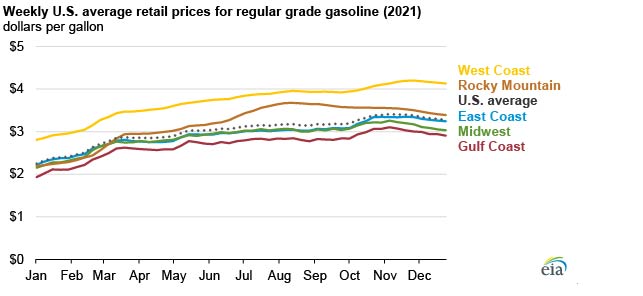
Rising crude oil prices and increased gasoline demand contributed to the average U.S. retail price for regular grade gasoline increasing to $3.01 per gallon (gal) in 2021, the highest average nominal price since 2014. The average price for retail gasoline increased by more than $1.00/gal between the start and the end of 2021.
The average U.S. retail gasoline price began the year at $2.25/gal. The average price first passed $3.00/gal on May 17, after disruptions to Colonial Pipeline operations, and it continued to increase after that, peaking at $3.41/gal on November 8 and finishing the year at $3.28/gal, which is $1.03/gal higher than at the start of the year.
Retail gasoline prices increased the most in the Rocky Mountains and on the West Coast because of refinery closures in those regions that led to reduced refinery output of gasoline and lower gasoline inventories. In addition, summer driving in the Rocky Mountains (when the number of visitors to national parks is at its highest) contributed to lower gasoline inventories and higher gasoline prices in that region.
One major contributor to the high retail gasoline prices was high crude oil prices. Crude oil prices in 2021 increased throughout most of the year, and the average crude oil price for 2021 was the highest price since 2018.
Other factors contributing to higher retail gasoline prices in 2021 include higher demand for gasoline, reduced U.S. refinery capacity, and low gasoline inventories. We estimated in our December 2021 Short-Term Energy Outlook (STEO) that U.S. gasoline consumption has mostly returned to pre-pandemic levels. We estimated that U.S. gasoline consumption averaged 8.8 million b/d in 2021, and consumption in the fourth quarter of 2021 totaled only 0.2 million b/d (2%) less than in the fourth quarter of 2019. U.S. gasoline production did not increase as much as consumption, contributing to gasoline inventory withdrawals of 25.5 million barrels (10%) from January 2021 to December 2021.










